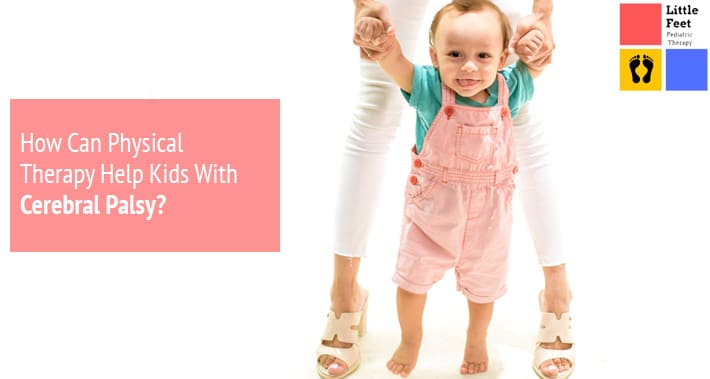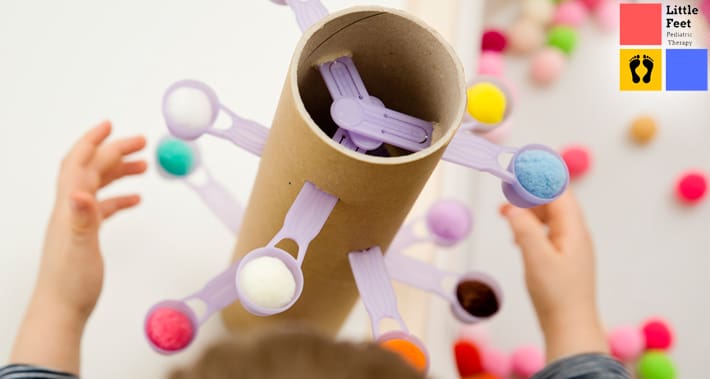
Cerebral palsy is a motor disability that occurs in childhood.
It can affect a person’s ability to physically move and maintain and coordinate their posture and balance.
If your child has been diagnosed with cerebral palsy, it can be an overwhelming and frightening experience for you both.
But there is hope.
At Little Feet Therapy, our pediatric physical therapists offer specialized treatment for children with cerebral palsy.
Pediatric physical therapy for cerebral palsy can help your child gain strength, manage their condition, and increase their ability to move and live an independent life.
We’re going to be taking a look at what cerebral palsy is, its various types, and how pediatric physical therapy can help children with cerebral palsy.
Keep reading to learn more.
What Is Cerebral Palsy?
Cerebral palsy refers to a group of permanent disorders of the development of movement and posture.
They cause activity limitations and muscle impairments.
Cerebral palsy is the most common motor disability in childhood.
Cerebral palsy is the result of abnormal brain development or an injury to the brain.
The injury can occur during pregnancy, during birth, or within the first couple of years after birth.
The injury is static, meaning damage will not progress over time.
This injury directly affects the development of motor skills, or physical movements.
There are numerous medical conditions as well that can lead to cerebral palsy, including ones of genetic origin.
This can include things like traumatic head injuries, lack of oxygen, strokes, infections, and more.
There are numerous types of cerebral palsy.
The type depends on what part of the body is affected and the type of movement problems that can be experienced.
All people with cerebral palsy have movement impairments.
However, some also have other concerns, including:
- Intellectual impairments
- Problems with vision, hearing or speech
- Joint problems
- Frequent seizures
Let’s take a closer look at the different types of cerebral palsy.
Spastic Cerebral Palsy
Spastic cerebral palsy is the most common form of this disorder.
It is characterized by increased muscle tone that limits the ability to move the impacted muscles.
The limbs and joints might feel tight and resist movement.
Other symptoms of spastic cerebral palsy include exaggerated reflexes and jerky movement patterns.
This can make it harder for children with spastic cerebral palsy to learn to roll, sit, crawl, and walk.
This type of cerebral palsy is also classified by which limbs are affected.
Spastic diplegia impacts both legs, spastic hemiplegia impacts only one side of the body (arm and leg), and spastic quadriplegia impacts both arms and legs.
Ataxic Cerebral Palsy
Ataxic cerebral palsy causes problems with balance and coordinating your body’s movements.
This can also make it difficult for your child to learn and coordinate new movements as they continue to develop.
Ataxic cerebral palsy is less common than other types of this disorder.
Due to the nature of its symptoms and issues with balance, children that have ataxic cerebral palsy may appear disorganized and clumsy in the movements they intentionally perform.
Challenges with ataxic cerebral palsy can range from difficulty learning how to walk to difficulty performing daily activities.
Particularly activities that involve fine motor skills, like writing or holding objects.
Dyskinetic Cerebral Palsy
Dyskinetic cerebral palsy involves issues with maintaining posture, which is the result of unpredictable changes in muscle tone and movement.
Children that have this type of cerebral palsy have difficulty controlling their body.
They experience quick involuntary movements in their limbs, like the hands, legs, and arms.
But they may also experience issues with controlling movements in other parts of their body, such as the face and tongue.
As a result, children with dyskinetic cerebral palsy may have difficulty talking and swallowing.
Hypotonic Cerebral Palsy
In hypotonic cerebral palsy, children have diminished muscle tone.
Their limbs, like their legs, hands, and arms, move very easily.
They can appear to be floppy or overly relaxed.
Complications with hypotonic cerebral palsy can include breathing issues and difficulty holding the head up.
As children mature, they may also experience difficulty with their posture and balance, walking, and talking.
Mixed Cerebral Palsy
Mixed cerebral palsy is characterized by a combination of symptoms from several other types of the disorder.
It commonly combines movement problems from dyskinetic, ataxic, or spastic cerebral palsy all at once.
Mixed cerebral palsy can be the result of having damage to multiple areas of the brain.
As a result, there can be a wide array of neurological or physical symptoms that can be present.
What Are Cerebral Palsy Levels?
Cerebral palsy can be measured in levels based on the Gross Motor Function Classification System, or GMFCS.
These levels are used to determine the extent of a child’s physical capabilities when they have cerebral palsy.
There are five levels in total.
Let’s take a closer look at them.
In level 1 cerebral palsy, children are typically able to walk without difficulty or limitations.
In level 2 cerebral palsy, children can typically walk without limitations, but may have difficulty jumping or running.
In level 3 cerebral palsy, children are more likely to have issues with walking, but are able to sit and stand with little or no support.
In level 4 cerebral palsy, children require assistive devices, such as a wheelchair, in order to walk.
In level 5 cerebral palsy, children require support to maintain their neck and head positions in order to sit and stand.
Cerebral Palsy Causes
Cerebral palsy is the result of damage to the brain, and is most commonly caused by a traumatic brain injury.
As we’ve already mentioned, these injuries typically occur before birth, during birth, or within the first couple of years after birth.
These injuries specifically affect the part of the brain responsible for coordinating muscles and controlling movements.
There can be several other causes of cerebral palsy as well.
These can include:
- Asphyxia neonatorum (not enough oxygen to the brain during labor)
- Genetic mutations
- Meningitis
- Severe jaundice
- Maternal injection
- Intracranial hemorrhage
- Encephalitis
However, the cause of cerebral palsy is usually not known in most cases, which makes this an idiopathic condition.
How Common Is Cerebral Palsy?
Cerebral palsy is the most commonly occurring childhood motor disability.
According to the CDC, about 1 in 345 children have been observed to have cerebral palsy.
This number can also increase further due to the increased survival rate of premature babies, who are at higher risk of having damage to the brain, and therefore cerebral palsy.
It also occurs more frequently in boys rather in girls, as well as more frequently in black children rather than white children.
As we mentioned earlier, spastic cerebral palsy is the most common type of the disorder.
In terms of the occurrence of severity, about 50%-60% of children who have cerebral palsy are able to walk independently.
While the cause of cerebral palsy is unknown, it’s good to keep in mind that there are risk factors for your child developing cerebral palsy before or during birth.
Refer to the previous section to see some contributing causes that can increase the likelihood of this disorder occurring.
Is Cerebral Palsy A Progressive Disorder?
The short answer is no.
Cerebral palsy is not a progressive disorder.
This means it doesn’t get worse over time.
Symptoms usually appear before your child is three or four years old, but can appear shortly after birth and can be diagnosed as young as 3 months.
Symptoms will vary person to person based on the extent of damage to the brain and the level of cerebral palsy.
As your child grows, they may experience increased difficulty carrying out various tasks in their daily life.
The good news is that with early intervention, physical therapy can provide support and help your child live a more independent life.

How Can Pediatric Physical Therapy Help With Cerebral Palsy?
Pediatric physical therapy for cerebral palsy revolves around increasing your child’s strength and movement.
They can provide tailored treatment plans to address your child’s particular needs based on their type of cerebral palsy.
A pediatric physical therapist will work with both you and your child to implement training strategies for positioning themselves, movement, playing, eating, and more.
They may also recommend ways to adapt your home and other environments to facilitate your child’s development.
When providing physical therapy for children, it’s a good idea to incorporate fun play activities to get your child engaged.
Ultimately these fun activities are designed to improve your child’s movement, strength, and function.
Some specific pediatric physical therapy treatments for cerebral palsy can include:
- Physical therapy for gross motor coordination
- Physical therapy for movement and mobility
- Physical therapy for balance and posture
- Physical therapy for developmental delays
- Education on assistive devices, such as a wheelchair
- Adaptive strategies for the home and other environments
Physical therapy treatment plans will continue to change and evolve as your child grows and enters new stages of development.
Your child’s physical therapist will monitor their development and make adjustments to their treatment plan accordingly.
They will continue encouraging mobility and fitness, and create treatment plans for pain management, preventing poor posture and balance, and improving and maintaining overall physical health.
Book Your Appointment With Little Feet Pediatric Therapy Today
If your child has been diagnosed with cerebral palsy, pediatric physical therapy can help.
At Little Feet Pediatric Therapy we offer specialized treatment for children with cerebral palsy.
Our pediatric physical therapists have received specialized training in early detection for cerebral palsy.
This includes training in both the General Movements Assessment and the Hammersmith Infant Neurological Exam approaches.
So if you suspect your child has cerebral palsy, we can evaluate them, and from there refer you to a medical specialist for further workup and diagnosis.
From there, we’ll will work with you and your child to increase their strength and movement so that they can live a more independent life.
Book your appointment with Little Feet Pediatric Therapy today.
► 3535 Randolph Rd, Charlotte, NC 28211
► 1331 H St NW Ste 200, Washington, DC 20005
► St. Louis, MO
► Raleigh, NC
Founded in 2019, Little Feet Therapy offers on site pediatric physical and occupational therapy treatments for children from 2 months to 18 years old with physical and developmental concerns. Our clinics focus on providing therapy in a child’s natural setting where your child is in familiar surroundings, it puts their mind at ease and helps them focus more on the work they’re doing with their pediatric therapist. Our therapists will work with your child at your home, at school, at daycare, or another place in the community where they feel most comfortable.